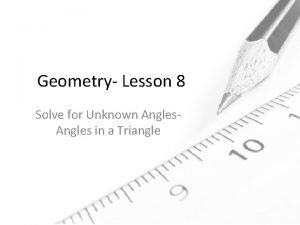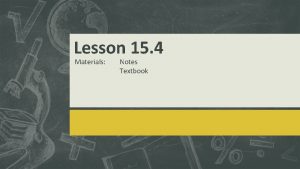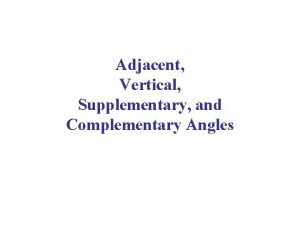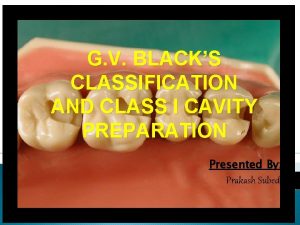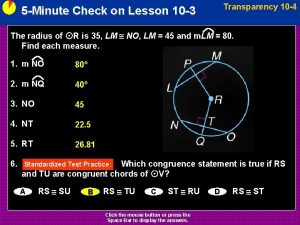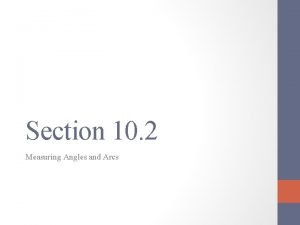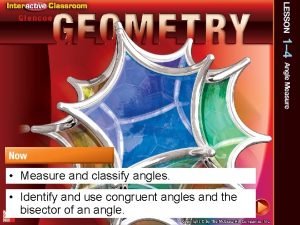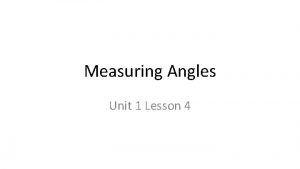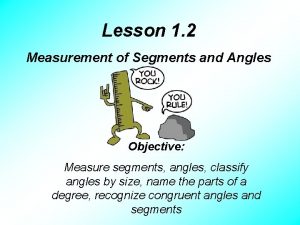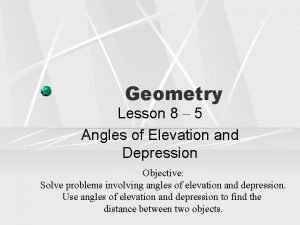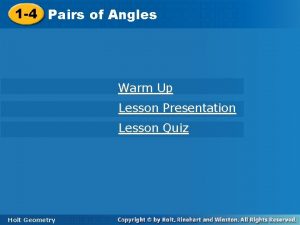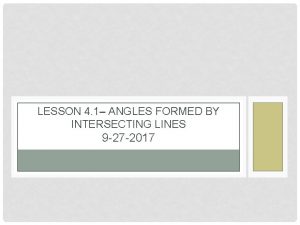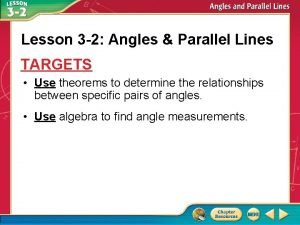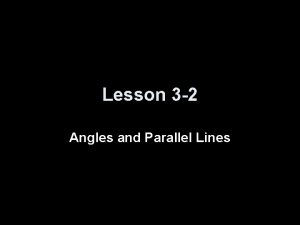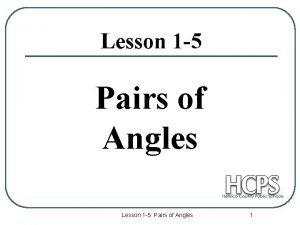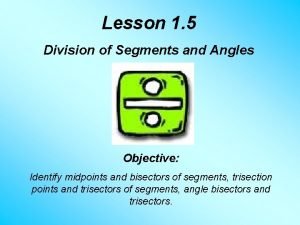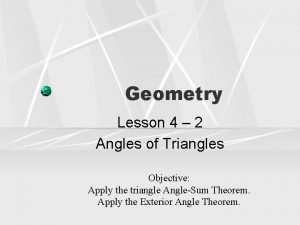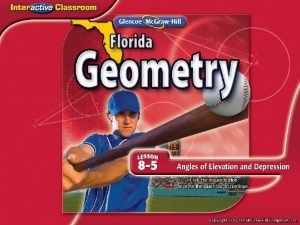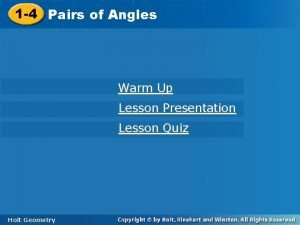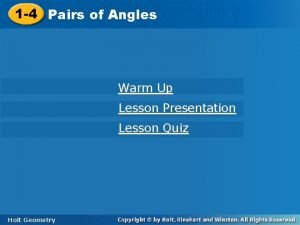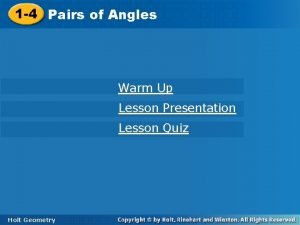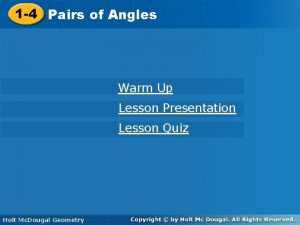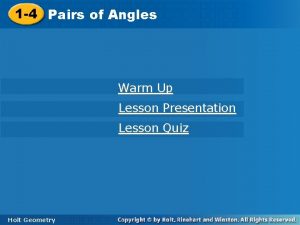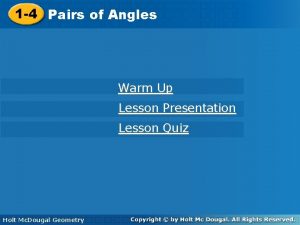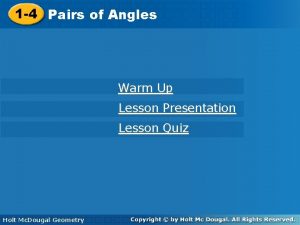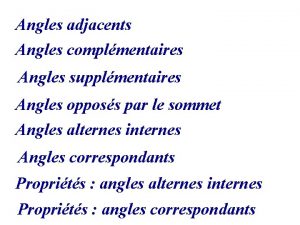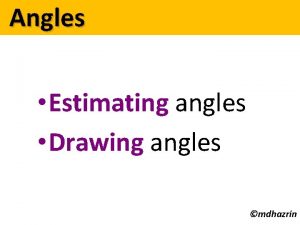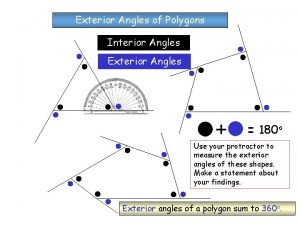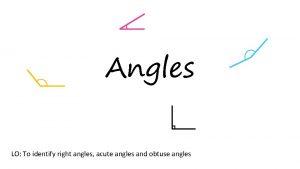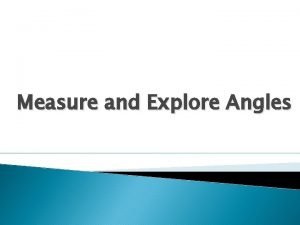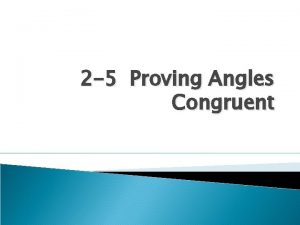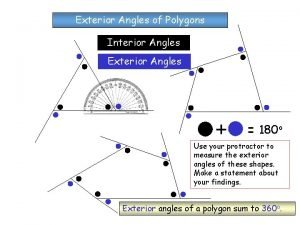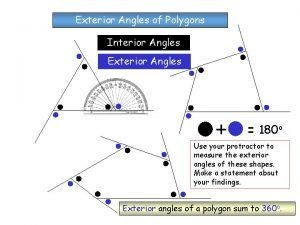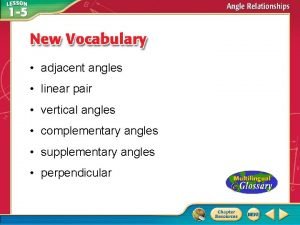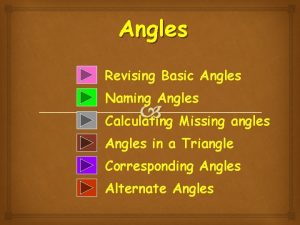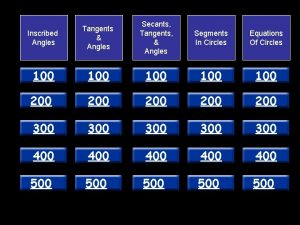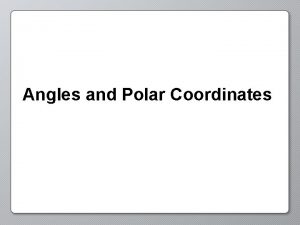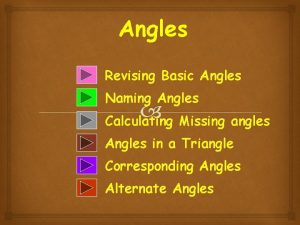1 4 Pairsofof Angles Warm Up Lesson Presentation
























- Slides: 24

1 -4 Pairsofof. Angles Warm Up Lesson Presentation Lesson Quiz Holt Geometry Holt Mc. Dougal Geometry

1 -4 Pairs of Angles Objectives Identify adjacent, vertical, complementary, and supplementary angles. Find measures of pairs of angles. Holt Mc. Dougal Geometry

1 -4 Pairs of Angles Vocabulary adjacent angles linear pair complementary angles supplementary angles vertical angles Holt Mc. Dougal Geometry

1 -4 Pairs of Angles Holt Mc. Dougal Geometry

1 -4 Pairs of Angles Another angle pair relationship exists between two angles whose sides form two pairs of opposite rays. Vertical angles are two nonadjacent angles formed by two intersecting lines. 1 and 3 are vertical angles, as are 2 and 4. Holt Mc. Dougal Geometry

1 -4 Pairs of Angles Holt Mc. Dougal Geometry

1 -4 Pairs of Angles Example 1 A: Identifying Angle Pairs Tell whether the angles are only adjacent, adjacent and form a linear pair, or not adjacent. AEB and BED have a common vertex, E, a common side, EB, and no common interior points. Their noncommon sides, EA and ED, are opposite rays. Therefore, AEB and BED are adjacent angles and form a linear pair. Holt Mc. Dougal Geometry

1 -4 Pairs of Angles Example 1 B: Identifying Angle Pairs Tell whether the angles are only adjacent, adjacent and form a linear pair, or not adjacent. AEB and BEC have a common vertex, E, a common side, EB, and no common interior points. Therefore, AEB and BEC are only adjacent angles. Holt Mc. Dougal Geometry

1 -4 Pairs of Angles Example 1 C: Identifying Angle Pairs Tell whether the angles are only adjacent, adjacent and form a linear pair, or not adjacent. DEC and AEB share E but do not have a common side, so DEC and AEB are not adjacent angles. Holt Mc. Dougal Geometry

1 -4 Pairs of Angles Check It Out! Example 1 a Tell whether the angles are only adjacent, adjacent and form a linear pair, or not adjacent. 5 and 6 are adjacent angles. Their noncommon sides, EA and ED, are opposite rays, so 5 and 6 also form a linear pair. Holt Mc. Dougal Geometry

1 -4 Pairs of Angles Check It Out! Example 1 b Tell whether the angles are only adjacent, adjacent and form a linear pair, or not adjacent. 7 and SPU have a common vertex, P, but do not have a common side. So 7 and SPU are not adjacent angles. Holt Mc. Dougal Geometry

1 -4 Pairs of Angles Check It Out! Example 1 c Tell whether the angles are only adjacent, adjacent and form a linear pair, or not adjacent. 7 and 8 have a common vertex, P, but do not have a common side. So 7 and 8 are not adjacent angles. Holt Mc. Dougal Geometry

1 -4 Pairs of Angles Example 2: Finding the Measures of Complements and Supplements Find the measure of each of the following. A. complement of F (90 – x) 90 – 59 = 31 B. supplement of G (180 – x) 180 – (7 x+10) = 180 – 7 x – 10 = (170 – 7 x) Holt Mc. Dougal Geometry

1 -4 Pairs of Angles Check It Out! Example 2 Find the measure of each of the following. a. complement of E (90 – x)° 90° – (7 x – 12)° = 90° – 7 x° + 12° = (102 – 7 x)° b. supplement of F (180 – x) 180 – 116. 5° = Holt Mc. Dougal Geometry

1 -4 Pairs of Angles Example 3: Using Complements and Supplements to Solve Problems An angle is 10° more than 3 times the measure of its complement. Find the measure of the complement. Step 1 Let m A = x°. Then B, its complement measures (90 – x)°. Step 2 Write and solve an equation. x = 3(90 – x) + 10 Substitute x for m A and 90 – x for m B. x = 270 – 3 x + 10 Distrib. Prop. x = 280 – 3 x Combine like terms. Divide both sides by 4. 4 x = 280 x = 70 Simplify. The measure of the complement, B, is (90 – 70) = 20. Holt Mc. Dougal Geometry

1 -4 Pairs of Angles Check It Out! Example 3 An angle’s measure is 12° more than the measure of its supplement. Find the measure of the angle. x = 0. 5(180 – x) + 12 Substitute x for m A and 180 - x for m B. x = 90 – 0. 5 x + 12 Distrib. Prop. x = 102 – 0. 5 x Combine like terms. 1. 5 x = 102 x = 68 Divide both sides by 1. 5. Simplify. The measure of the angle is 68. Holt Mc. Dougal Geometry

1 -4 Pairs of Angles Example 4: Problem-Solving Application Light passing through a fiber optic cable reflects off the walls of the cable in such a way that 1 ≅ 2, 1 and 3 are complementary, and 2 and 4 are complementary. If m 1 = 47°, find m 2, m 3, and m 4. Holt Mc. Dougal Geometry

1 -4 Pairs of Angles 1 Understand the Problem The answers are the measures of 2, 3, and 4. List the important information: • 1 2 • 1 and 3 are complementary, and 2 and 4 are complementary. • m 1 = 47° Holt Mc. Dougal Geometry

1 -4 Pairs of Angles Check It Out! Example 4 What if. . . ? Suppose m 3 = 27. 6°. Find m 1, m 2, and m 4. Holt Mc. Dougal Geometry

1 -4 Pairs of Angles 1 Understand the Problem The answers are the measures of 1, 2, and 4. List the important information: • 1 2 • 1 and 3 are complementary, and 2 and 4 are complementary. • m 3 = 27. 6° Holt Mc. Dougal Geometry

1 -4 Pairs of Angles Example 5: Identifying Vertical Angles Name the pairs of vertical angles. HML and JMK are vertical angles. HMJ and LMK are vertical angles. Check m HML m JMK 60°. m HMJ m LMK 120°. Holt Mc. Dougal Geometry

1 -4 Pairs of Angles Check It Out! Example 5 Name a pair of vertical angles. Do they appear to have the same measure? Check by measuring with a protractor. EDG and FDH are vertical angles and appear to have the same measure. Check m EDG ≈ m FDH ≈ 45° Holt Mc. Dougal Geometry

1 -4 Pairs of Angles Lesson Quiz: Part I m A = 64. 1°, and m B =(4 x – 30)°. Find the measure of each of the following. 1. supplement of A 115. 9° 2. complement of B (120 – 4 x) ° 3. Determine whether this statement is true or false. If false, explain why. If two angles are complementary and congruent, then the measure of each is 90°. False; each is 45°. Holt Mc. Dougal Geometry

1 -4 Pairs of Angles Lesson Quiz: Part II m XYZ = 2 x° and m PQR = (8 x - 20)°. 4. If XYZ and PQR are supplementary, find the measure of each angle. 40°; 140° 5. If XYZ and PQR are complementary, find the measure of each angle. 22°; 68° Holt Mc. Dougal Geometry
 Vertically opposite angles are congruent
Vertically opposite angles are congruent Lesson 8 solve for unknown angles—angles in a triangle
Lesson 8 solve for unknown angles—angles in a triangle Segment relationships in circles lesson 15-4
Segment relationships in circles lesson 15-4 Angles & lines unit warm ups
Angles & lines unit warm ups 3 parallel lines and transversals
3 parallel lines and transversals Vertical angles
Vertical angles Gv blacks classification
Gv blacks classification Diameters of fetal head
Diameters of fetal head Leopold maneuver
Leopold maneuver 10-4 inscribed angles answers
10-4 inscribed angles answers Vertical angles
Vertical angles Lesson 1 classify angles answers
Lesson 1 classify angles answers Straight angle
Straight angle Lesson 4 classify angles
Lesson 4 classify angles Measuring angles and segments
Measuring angles and segments 8-5 angles of elevation and depression brewton
8-5 angles of elevation and depression brewton 1-4 pairs of angles lesson quiz answers
1-4 pairs of angles lesson quiz answers 4.1 angles formed by intersecting lines answer key
4.1 angles formed by intersecting lines answer key Lesson 3-2 angles and parallel lines answers
Lesson 3-2 angles and parallel lines answers How to tell if two lines are parallel geometry
How to tell if two lines are parallel geometry What is a linear pair
What is a linear pair Lesson 1 how to bisect segments and angles
Lesson 1 how to bisect segments and angles Topic 2 angles of triangles
Topic 2 angles of triangles Lesson 8-4 angles of elevation and depression answer key
Lesson 8-4 angles of elevation and depression answer key Unit 3 lesson 4 proving angles congruent
Unit 3 lesson 4 proving angles congruent

